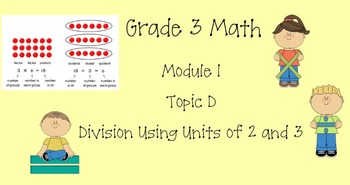Grade 3 Math Module 1 Topic D
Lisa Staskowski
16 Followers
Grade Levels
3rd
Subjects
Resource Type
Standards
CCSS3.OA.A.2
CCSS3.OA.A.3
CCSS3.OA.A.4
CCSS3.OA.B.6
CCSS3.OA.C.7
Formats Included
- NOTEBOOK (SMARTboard) File
Pages
82 pages
Lisa Staskowski
16 Followers
Description
In Topic D students solve two kinds of division situations—partitive (group size unknown) and measurement (number of groups unknown)—using factors of 2 and 3. The tape diagram is introduced in Lesson 11 as a tool to help students recognize and distinguish between types of division. By the end of Lessons 11 and 12 students independently draw and label tape diagrams that help them to compare and analyze problems that may use the same division sentence, but have quotients representing different things.
Lesson 13 solidifies growing understanding that the unknown can also be found from the related multiplication sentence. Students initially work through word problems using arrays and tape diagrams to practice solving the two types of division, then transition to problem solving using abstract division and multiplication equations.
Lesson 13 solidifies growing understanding that the unknown can also be found from the related multiplication sentence. Students initially work through word problems using arrays and tape diagrams to practice solving the two types of division, then transition to problem solving using abstract division and multiplication equations.
Total Pages
82 pages
Answer Key
N/A
Teaching Duration
3 days
Last updated Aug 20th, 2014
Report this resource to TPT
Reported resources will be reviewed by our team. Report this resource to let us know if this resource violates TPT’s content guidelines.
Standards
to see state-specific standards (only available in the US).
CCSS3.OA.A.2
Interpret whole-number quotients of whole numbers, e.g., interpret 56 ÷ 8 as the number of objects in each share when 56 objects are partitioned equally into 8 shares, or as a number of shares when 56 objects are partitioned into equal shares of 8 objects each. For example, describe a context in which a number of shares or a number of groups can be expressed as 56 ÷ 8.
CCSS3.OA.A.3
Use multiplication and division within 100 to solve word problems in situations involving equal groups, arrays, and measurement quantities, e.g., by using drawings and equations with a symbol for the unknown number to represent the problem.
CCSS3.OA.A.4
Determine the unknown whole number in a multiplication or division equation relating three whole numbers. For example, determine the unknown number that makes the equation true in each of the equations 8 × ? = 48, 5 = __ ÷ 3, 6 × 6 = ?.
CCSS3.OA.B.6
Understand division as an unknown-factor problem. For example, find 32 ÷ 8 by finding the number that makes 32 when multiplied by 8.
CCSS3.OA.C.7
Fluently multiply and divide within 100, using strategies such as the relationship between multiplication and division (e.g., knowing that 8 × 5 = 40, one knows 40 ÷ 5 = 8) or properties of operations. By the end of Grade 3, know from memory all products of two one-digit numbers.





